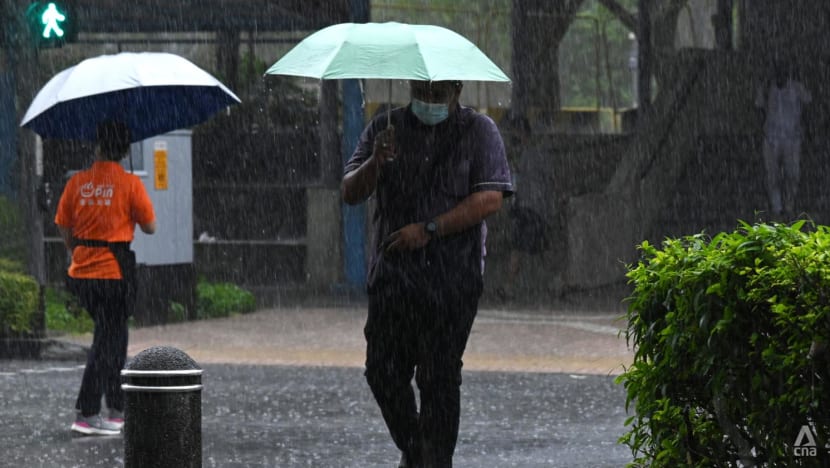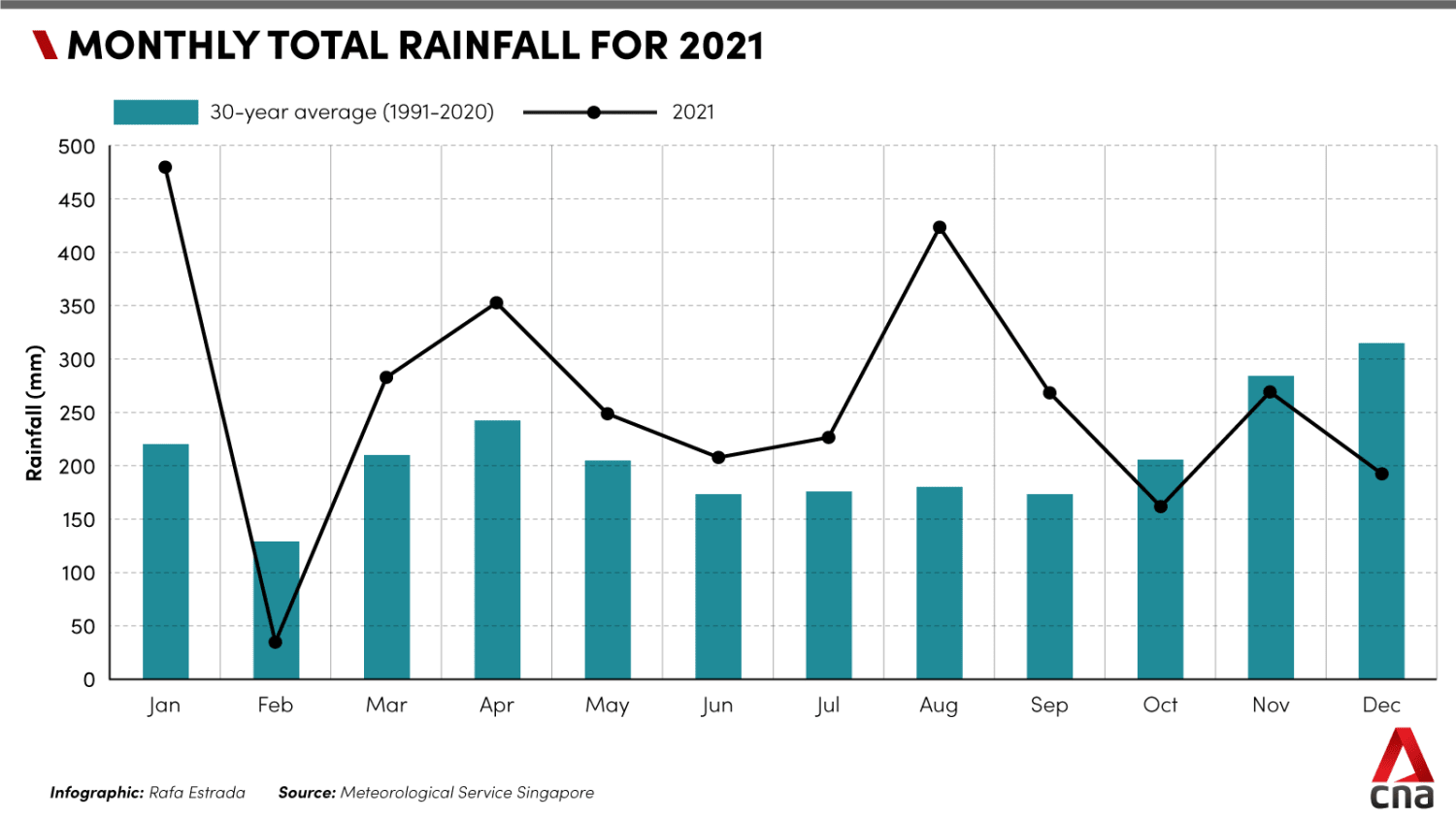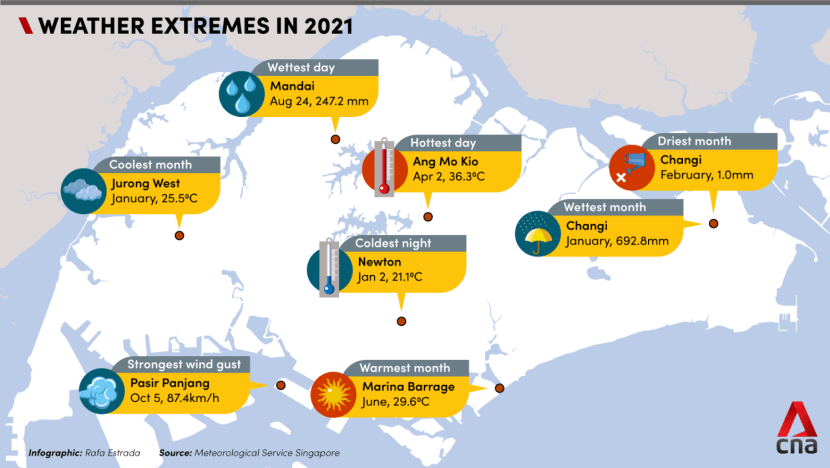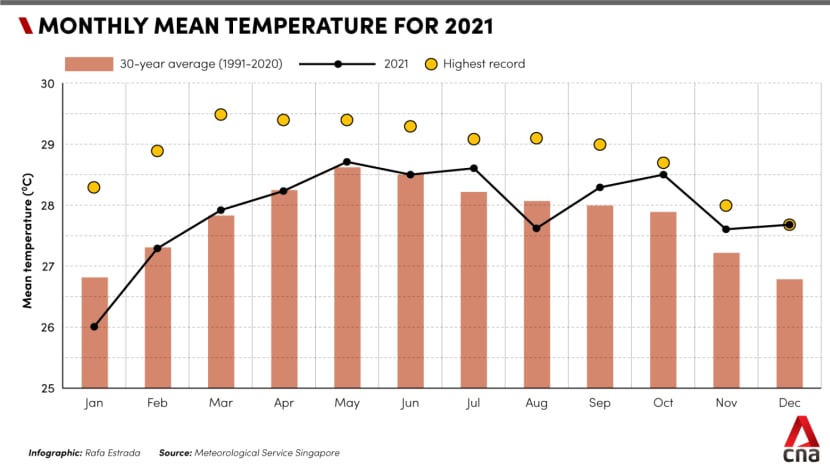Wet and windy: How Singapore saw some unusual weather in 2021
2021 was the second wettest year since 1980, with August being "unseasonably wet" despite typically being among the drier months of the year, according to a report by Meteorological Service Singapore (MSS).

A man crossing the road in the rain. (File photo: CNA/Gaya Chandramohan)
SINGAPORE: Singapore marked 2021 as its second wettest year since 1980, with January logging the most rain in more than 100 years.
The past year saw "significantly wetter-than-average" conditions for Singapore, with the annual total rainfall at the Changi climate station being 33 per cent higher than the long-term average, according to a report released by the Meteorological Service Singapore (MSS) on Friday (Jan 28).
Most months in 2021 experienced "above-average" rainfall, with almost all of those months also ranking within the top 10 wettest for the respective months over the past 40 years based on the islandwide average, said MSS.

WET JANUARY
The report highlighted several notable weather events in 2021.
MSS noted that Singapore experienced "exceptionally wet and cool weather" in the first half of January due to a Northeast Monsoon surge. This brought "continuous widespread rain" over Singapore in the first weekend of the year.
A week later, another monsoon surge brought more windy and rainy weather.
In the first fortnight alone, 648.4 mm of rainfall was recorded.
"Notably, at the Changi climate station, significantly above-average rainfall was recorded in January with a total rainfall of 692.8 mm, the highest in the past 100 years for the month of January," added MSS.
The coldest night was recorded by the Newton climate station on Jan 2, with a temperature of 21.1 degrees Celsius.

DRY, WINDY FEBRUARY
In contrast to the wet January, Singapore experienced a "very dry" February.
The highest daily total rainfall measured was 46.9 mm at the Jurong West climate station, while the Changi climate station recorded only 1.0 mm for the entire month.
This made for the second driest February on record after 2014, said MSS.
February was also a "very windy" month. The Changi climate station recorded an average daily wind speed of 13.1 kmh, making last February the second windiest February since the MSS started to record continuous wind records in 1984.
"UNSEASONABLY WET" AUGUST
Normally among the drier months of the year, August 2021 came in “well-above” average rainfall islandwide. The Changi climate station recorded nearly twice its long-term monthly average.
There were two days with exceptionally heavy rain that led to flash floods in some areas.
Aug 24 was the wettest day of the year, due to several spells of moderate to heavy thundery showers that fell over the island in the morning hours.
A "remarkable" daily total rainfall of 247.2 mm was recorded at the Mandai climate station, setting a record for the highest daily total rainfall for the month of August, stated the report.
The other day with exceptionally heavy rain was Aug 20.
WARMEST DECADE
Despite the wetter conditions in 2021 that helped to moderate Singapore's overall temperature, the period from 2012 to 2021 was still the country's warmest decade on record, said MSS.
The mean temperature during the decade was 27.97 degrees Celsius, 0.02 degrees Celsius higher than the previous record from 2010 to 2019. The annual mean temperature in 2021 was 27.9 degrees Celsius – 0.1 degrees Celsius above the long-term average.

Singapore's annual temperature trends in 2021 are similar to global trends reported, added MSS.
"At a global level, with temporary cooling from La Nina conditions early in the year, 2021 is expected to be between the fifth and seventh warmest year on record," said MSS.
La Nina refers to the large-scale cooling of surface temperatures in the central and eastern equatorial Pacific Ocean, with widespread impact on weather around the world.
The phenomenon, which typically has the opposite impact as the warming El Nino phenomenon, usually occurs every two to seven years, but has now hit twice since 2020.
La Nina conditions and negative Indian Ocean Dipole (IOD) events typically result in wetter-than-average conditions over Singapore and the nearby region, particularly during the Southwest Monsoon season, said MSS.
The IOD is a natural climate phenomenon that influences rainfall patterns around the Indian Ocean.
In 2021, the hottest day was recorded by the Ang Mo Kio climate station, clocking a temperature of 36.3 degrees Celsius, while the Marina Barrage climate station recorded June as the warmest month with an average temperature of 29.6 degrees Celsius.



















